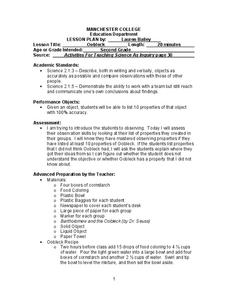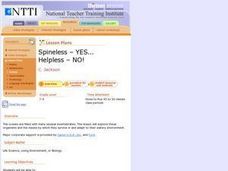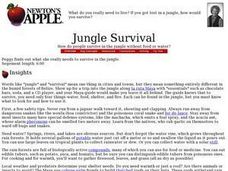Curated OER
That Was Then, This Is Now
Students examine the price of food over time. They analyze charts, perform math operations and compare and contrast data about the price of food. They complete worksheets while interperting the charts.
Curated OER
Energy/Light/Heat/Sound
Fourth graders study the properties of heat in this series of lessons. They discuss sources of heat and experiment to determine its properties. They identify insulators and conductors by measuring temperatures, and graphing their data....
Curated OER
Investigation Xylem
Students investigate how water travels up the stem of vascular plants by using food coloring to stain the xylem of a number of different plants. They know the function of leaves, stems, and root at the end of the experiment.
Curated OER
Earth Day Crossword Puzzle-- Difficult
In this science worksheet, students participate in an Earth Day activity by completing a crossword puzzle. Students read each clue. The answer which fits in the puzzle is provided in a scrambled word form. Students unscramble the words...
Curated OER
Do the Research! (Different Trivia Questions)
For this research worksheet, students use books or the Internet to find the answers to 9 questions. After writing the answer, students list the source used.
Curated OER
BIRDS OF A FEATHER
Students observe and identify characteristics of artifacts and fossils; explain how artifacts and fossils are used to explore the past; and identify ways that Native Americans prepared food and made tools
Curated OER
Ecological Relationships
Middle schoolers identify ecological elements and their factors on species, populations and food webs. They analyze ecosystems for these elements and research how these factors influence species survival rate. Predictions on conditions...
Curated OER
Introduction to Digestion: What Happens to a Hamburger?
Students explore the human body by analyzing how food is absorbed. In this food digestion lesson plan, students utilize health vocabulary terms by participating in a guessing game activity. Students discuss their own eating habits and...
Curated OER
Lesson 9 - Along Our Coast
Learners study the benefits of estuaries. They construct a saltwater food web, and complete worksheets and a quiz.
Curated OER
Let's Start Growing
Students investigate how a tree grows from a seed. In this plant biology instructional activity, students use potting soil, tree seeds, and a paper cup to observe seeds growing into plants. Students record observations in their science...
Curated OER
Oobleck
Second graders observe the properties of Oobleck. In this science and observation instructional activity, 2nd graders examine Oobleck and make a list of 10 properties that they notice. They explain their observations.
Curated OER
Bubble and Squeak
Students complete a unit on the chemical and technological processes of food preparation. They observe various experiments, describe changes in materials through cooking, identify safety and hygiene issues, and cook various recipes.
Curated OER
Spineless - YES... Helpless - NO!
Students distinguish between invertebrate and vertebrate organisms while examining the zoological classes of a number of invertebrates. They illustrate a food web of these organisms and investigate the impact of humans on the oceanic...
Curated OER
Limu in Your Lunch
Students explore various types of algae found in Hawaii. In this science lesson, students research species of the three types of limu and identify various uses. Students explore products that contain limu.
Curated OER
Eggs: A Practical Application
Students examine the chemical and physical nature of eggs and their role in food preparation.
Curated OER
Nutrition in Space
Learners compare and contrast the process of dehydration with the processes of freezing and canning. They predict energy sources that may be accessible in the future in different environments such as the moon and planets, most notably Mars.
Curated OER
Experimenting with Yeast Metabolism
Ninth graders determine the rate of respiration by yeast and which sugars can be used as a food source by yeast using a CO2 gas sensor and computer software. This instructional activity is for an honors Biology class.
Curated OER
Abundant Lakes
Students define lake life zones. They define stormwater runoff and its effects on lakes. They identify the relationship between decaying substances and water pollution. They construct a freshwater food web.
Pennsylvania Department of Education
Pennsylvania’s Energy Supply
Third graders become familiar with the various types of energy and which types are found in Pennsylvania. In this Pennsylvanian energy resources lesson, 3rd graders, identify wind and water as sources of energy. Students complete an...
Curated OER
Life Cycle Literature Briefs
Literature containing life cycle information is available from many sources. Several examples of this type of literature are listed below with a synopsis and sample questions for each. These examples have been taken from a variety of...
Curated OER
Biomass: The Energy of the Future
Students research renewable fuels. In this alternative energy instructional activity, students compile information and create a comparison chart on renewable resources. This instructional activity includes additional suggested readings,...
Curated OER
Jungle Survival
Students make a chart with columns for water, food, shelter, fire, and other needs.Then list whatever each person thinks they might need in each column to survive for at least a week in the outdoors during that season.
Curated OER
What Makes up an Ecosystem?
Eighth graders design posters of working ecosystems using pictures from magazines. They label autotrophic, heterotropic, or saprotrophic energy sources, and identify predators and prey.
Curated OER
Animal Research Project
First graders are introduced to the topic of researching by the librarian. Using a worksheet, they use various sources in the library to choose one animal from various groups. They complete a fact sheet on each animal and report their...

























